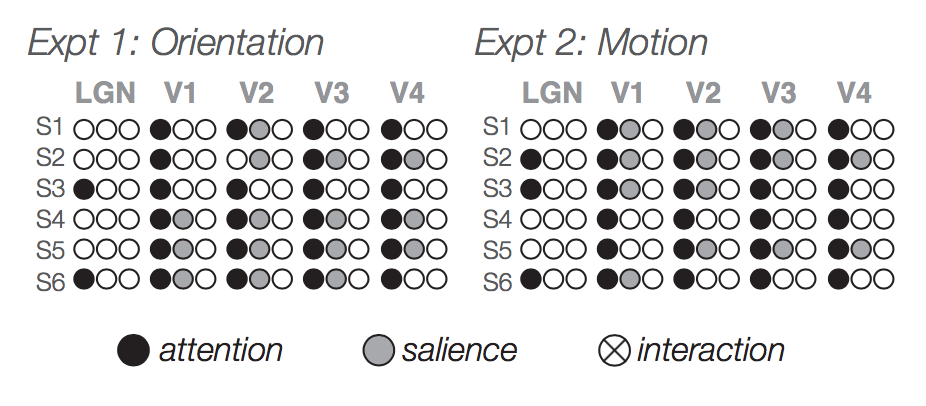Characterizing the effects of feature salience and top-down attention in the early visual system
Journal of Neurophysiology (2017)
, , ,
The visual system employs a sophisticated balance of attentional mechanisms: salient stimuli are prioritized for visual processing, yet observers can also ignore such stimuli when their goals require directing attention elsewhere. A powerful determinant of visual salience is local feature contrast: if a local region differs from its immediate surround along one or more feature dimensions, it will appear more salient. Here, we used high-resolution fMRI at 7T to characterize the modulatory effects of bottom-up salience and top-down voluntary attention within multiple sites along the early visual pathway, including visual areas V1-V4 and the lateral geniculate nucleus (LGN). Observers viewed arrays of spatially distributed gratings, where one of the gratings immediately to the left or right of fixation differed from all other items in orientation or motion direction, making it salient. To investigate the effects of directed attention, observers were cued to attend to the grating to the left or right of fixation, which was either salient or non-salient. Results revealed reliable additive effects of top-down attention and stimulus-driven salience throughout visual areas V1-hV4. In comparison, the LGN exhibited significant attentional enhancement but was not reliably modulated by orientation- or motion-defined salience. Our findings indicate that top-down effects of spatial attention can influence visual processing at the earliest possible site along the visual pathway, including the LGN, while the processing of orientation- and motion-driven salience primarily involves feature-selective interactions that take place in early cortical visual areas.
visual system employs a sophisticated balance of attentional mechanisms: salient stimuli are prioritized for visual processing, yet observers can also ignore such stimuli when their goals require directing attention elsewhere. A powerful determinant of visual salience is local feature contrast: if a local region differs from its immediate surround along one or more feature dimensions, it will appear more salient. Here, we used high-resolution fMRI at 7T to characterize the modulatory effects of bottom-up salience and top-down voluntary attention within multiple sites along the early visual pathway, including visual areas V1-V4 and the lateral geniculate nucleus (LGN). Observers viewed arrays of spatially distributed gratings, where one of the gratings immediately to the left or right of fixation differed from all other items in orientation or motion direction, making it salient. To investigate the effects of directed attention, observers were cued to attend to the grating to the left or right of fixation, which was either salient or non-salient. Results revealed reliable additive effects of top-down attention and stimulus-driven salience throughout visual areas V1-hV4. In comparison, the LGN exhibited significant attentional enhancement but was not reliably modulated by orientation- or motion-defined salience. Our findings indicate that top-down effects of spatial attention can influence visual processing at the earliest possible site along the visual pathway, including the LGN, while the processing of orientation- and motion-driven salience primarily involves feature-selective interactions that take place in early cortical visual areas.

